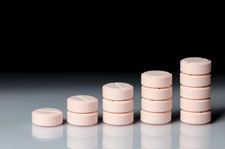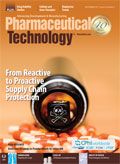Scaling Up a Continuous Granulation Process
Continuous twin-screw granulation offers several options for increasing production scale. Thermo Fisher Scientific explains factors to consider in scale-up projects for manufacturing oral solid-dosage drugs.
Christopher Slesarchik/shutterstock.com

In manufacturing drug tablets, granulation may be performed prior to the tableting step to improve a powder’s flow and compaction properties. An alternative to traditional batch granulation for continuous tableting is continuous granulation using a twin-screw extruder. “We continue to see demand in the pharmaceutical industry to switch from batch to continuous manufacturing, as pharmaceutical manufacturers recognize that its benefits include reduced costs, smaller facility footprints necessary, and minimal loss of material and API,” notes Dirk Leister, technical marketing manager, process and pharma extruders for Thermo Fisher Scientific.
Another benefit of continuous manufacturing is flexibility of scale, as in many cases the equipment can be run for a longer time period to produce a larger amount of material instead of using larger equipment. Scale-up from laboratory to commercial scale, however, may still be required. Thermo Fisher Scientific, which manufactures twin-screw extruders for pharmaceutical development and manufacturing, is in the early stages of developing a model to support customers engaged in twin-screw granulation scale-up projects. Pharmaceutical Technology spoke with Leister about considerations for scaling up a twin-screw wet granulation process.
Scale-up parameters
PharmTech: When scaling up a wet granulation process, what product endpoints must be the same in the laboratory and commercial scale, and how are these best measured?
Leister (Thermo): Particle size and particle size distribution are critical parameters, as they influence the tablet properties as well as the drug release profile. These parameters are critical quality attributes affecting the final product. They play an important role in scale-up from development and small-scale runs to full production.
Traditional batch granulation methods use established offline analytical methods to determine these parameters. A recognized analysis to determine the particle size distribution is the sieve analysis. Continuous granulation processes using twin-screw granulation require online, process analytical technology (PAT) tools to deliver comparable results. Optical methods have been proven to characterize the continuous granulation process very well and can therefore be used as PAT tools in continuous processes.
Another critical parameter is residual moisture in the granule after drying, as this influences the processability of the granule in the final tablet and API distribution in the granule and the tablet itself. This parameter is typically monitored using inline, near infrared (NIR) spectroscopic methods.
PharmTech: One of the advantages of a continuous, twin-screw process is the ability to quickly change parameters and perform designed experiments to define a process window. What are the typical parameters that must be considered for a twin-screw wet granulation process? Which of these factors are critical for scale-up?
Leister (Thermo): Twin-screw granulation has been identified as a viable option in today’s drug formulation marketplace, and it has been validated in a variety of papers and publications that discuss the influence of different process parameters on the critical quality attributes of the final tablet. Most of these papers, including those based on research and experiments conducted by Thermo Fisher Scientific, emphasize that the influence these parameters have on the final product is very much dependent on the specific drug formulation.
Particle size and distribution is affected by the liquid-to-solid (L/S) ratio. The twin-screw granulation process typically reaches a steady state quickly after the L/S ratio is changed, which means that process parameters can be observed as the extruder is running, saving a considerable amount of time in process development or the quality control process.
Twin-screw granulation offers a reliable, effective way to tailor particle properties by changing process parameters such as screw speed and throughput. In addition to the screw design (the sequential arrangement of conveying and mixing zones within the screw setup), screw speed determines the mechanical energy input and therefore influences the agglomeration process and particle break-up. The filling level inside the extruder screw determines the probability of particle–particle interaction and is also an important factor in the formation of agglomerates. All of these critical parameters require observation during process scale-up (i.e., to a larger extruder) and/or scale-out (i.e., to multiple extruders of the same size).
Scaling up a continuous process
PharmTech: What should be considered when scaling up a process from a smaller diameter twin-screw extruder to a larger one?
Leister (Thermo): A chief advantage of continuous processes is that they are time based rather than volume based (as is the case with batch processes). When a greater quantity of product is needed in a batch process, a second or successive batch must be run-which may entail some batch-to-batch variation. In a continuous process, however, a greater quantity can be produced by simply running and monitoring the process for a longer time. Throughput on the same scale also has quite a wide range. For a lactose-based formulation, we ran a process on a 16-mm extruder from 1 kg/h up to 15 kg/h with consistency in the critical quality attributes of the final granules. Scale-up is, therefore, not always necessarily the first and only option to increase the output of a twin-screw process. Additionally, when looking at the lifecycle of a drug product, it is not always necessary to produce with full capacity. A second twin-screw granulation unit at the same scale can be used to double the output and bridge the time when really high amounts are requested in a relatively short period of time.
Having said that, in an early R&D stage the availability of material is usually limited, therefore experiments on a small scale, such as an 11-mm screw-diameter, can help to save a significant amount of material and development time. In a typical scale-up project from development to production, each extruder should exhibit similar machine geometries. Parameters such as the inner to outer diameter ratio of the screws, length to diameter ratio of the barrel, and the geometry of individual screw elements help to transfer process parameters from small scale to the production scale. If the small-scale process is robust and stable, a direct scale up from R&D to final production size (e.g., 11 mm to 24 mm or even 36 mm screw diameter) should easily be accomplished. It is not necessary, nor does it make economic sense, to go from one scale-up step to the next (i.e., from 11 mm to a larger extruder, such as 16, 24, or 36-mm diameter) until the project’s final output is determined.
Article Details
Pharmaceutical Technology
Vol. 41, No. 9
September 2017
Pages: 30–31
Citation:
When referring to this article, please cite it as J. Markarian, " Scaling Up a Continuous Granulation Process," Pharmaceutical Technology 41 (9) 2017.

Drug Solutions Podcast: A Closer Look at mRNA in Oncology and Vaccines
April 30th 2024In this episode fo the Drug Solutions Podcast, etherna’s vice-president of Technology and Innovation, Stefaan De Koker, discusses the merits and challenges of using mRNA as the foundation for therapeutics in oncology as well as for vaccines.